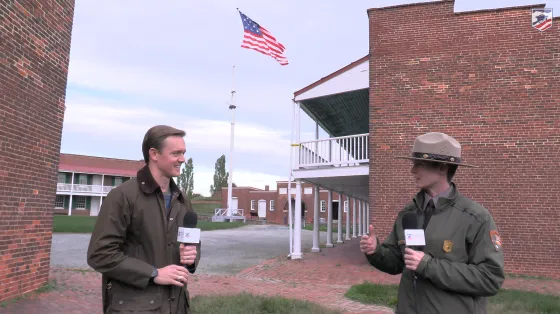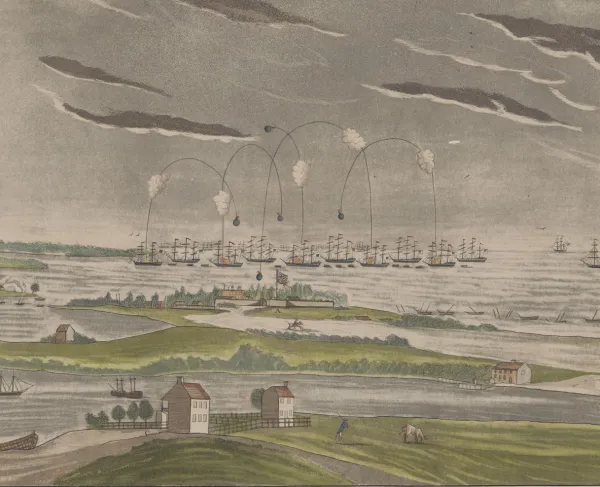Students Across the Nation Provided With a Window Into Baltimore’s Star-Spangled Past
Colleen Cheslak, (202) 367-1861 x7234
(Baltimore, Md.) – History takes on a whole new meaning when explored from the field. The American Battlefield Trust has repeatedly proven this to be true, sending more than 35,000 students to scores of battlefields and historic sites through its successful Field Trip Fund. However, student access to these storied locations has grown increasingly difficult. Between pandemic precautions, limited financial resources and the constant factor of distance, field trips — coveted by students — are far and few between. Now, the Trust seeks to create a digital pathway to place-based education through the debut of its first Star-Spangled Banner Virtual Field Trip to Baltimore, Md.
“America’s students crave visual resources to bring the subject of history to life, and the Trust has been steadily tuned in to the needs of these young learners,” said organization President David Duncan. “With the introduction of the Star-Spangled Banner Virtual Field Trip, our hope is that students feel as if they are trekking along with us as we explore some of Charm City’s most notable War of 1812 sites.”
At the outset of the War of 1812, Baltimore was the third largest city in the United States, with a population of 47,000 and a booming port for trade protected by Fort McHenry, built along the entrance to Baltimore Harbor on the Patapsco River. When the British set their course for destruction along the Chesapeake Bay, Baltimore readied itself for the impending clash, with tensions felt across a broad spectrum of social and economic classes.

Offering insight into what is arguably America’s most overlooked war, the Star-Spangled Banner Virtual Field Trip takes viewers to Fort McHenry National Monument and Historic Shrine, Hampton National Historic Site and the Star-Spangled Banner Flag House in 70 minutes. Host Douglas Ullman, Jr., is seen walking the ground where history happened and speaking with experts at the National Park Service about the wartime events and personalities that cemented these locations in our national narrative. He even encounters the “defenders of Baltimore” — costumed interpreters that acquaint audiences with the roles and everyday lives of Fort McHenry’s soldiers. These up-close experiences provide a clear window into the past for students that may otherwise struggle to grasp these stories from a traditional textbook.
“The National Park Service is excited to collaborate with the American Battlefield Trust to provide students everywhere with opportunities to explore the rich and complex history of Baltimore through Fort McHenry National Monument and Historic Shrine, and Hampton National Historic Site,” said Superintendent David H. Moore. “This project helps us to share the parks’ unique resources with classrooms across the country, and to foster a sense of stewardship of these treasured places and a connection with the inspiring stories of men and women who have shaped nearly 250 years of American history.”
In sharing this eye-opening resource with educators, the Trust has packaged it alongside an option for live components, additional supporting videos, digital assets and a panoptic question sheet to provide for flexible and easy implementation in the classroom. With these materials working in concert, the subject matter can be explored through a military, civilian, geographic and cultural lens, and thus provide interest for a wide spectrum of students.
The Charm City endeavor, made possible through the generosity of the Bowe Stewart Foundation, marks the beginning of the organization’s ambitious initiative to deliver even more virtual field trips, from historic locations like New Orleans, Boston, and Washington, D.C. Supported by a battlefield interpretation grant from the National Park Service’s American Battlefield Protection Program, these classroom tools will continue to highlight battlefield sites from the Revolutionary War, War of 1812 and Civil War, all while seeking a wider context of the historic conflicts.
The American Battlefield Trust’s educational resources do not only take the form of field trips. Offerings include a two-fold Civil War curriculum (traditional and inquiry-based), with a Revolutionary War iteration in the making; a Traveling Trunk program to encourage hands-on learning; online Revolutionary and Civil War Crash Courses; a collection of more than 700 online videos; on-site and virtual Teacher Institutes; thousands of articles on historic events; biographies on various figures; primary sources, maps, quizzes and more that can be found at www.battlefields.org/learn.
The American Battlefield Trust is dedicated to preserving America’s hallowed battlegrounds and educating the public about what happened there and why it matters today. The nonprofit, nonpartisan organization has protected more than 54,000 acres associated with the Revolutionary War, War of 1812, and Civil War. Learn more at www.battlefields.org.
###



